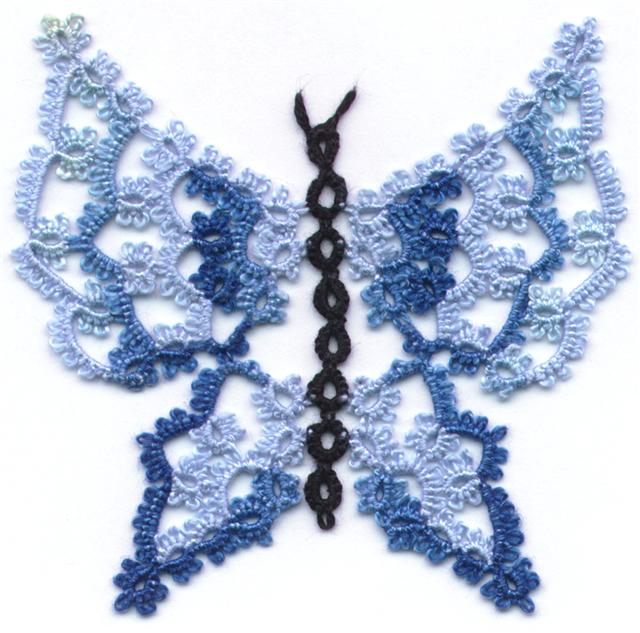
The larger spools of thread are Machine Quilting and Crafts thread size #50. These were all plastic wrapped and it was hard to tell what size 50 would look like tatted up, but I was thinking I might do a doily with the thread so I bought enough for that purpose. I opened one of the spools and tatted a wee ring when I got home.

Size 50 is, well, tiny as far as doily threads go. It's fine enough to make bookmarks out of although they'd be a little thicker that I like. Size 50 wouldn't be my first choice for doily thread.

They also had both metal and plastic Susan Bates shuttles. Again not my first choice for tatting but at $1.50 I got one anyway. Even if I don't use it, it gives me a shuttle I can give away if I need to, or one to show students what is available and point out the differences between the metal and plastic shuttles.
If you look close at the base of the dark blue thread you'll see a tiny ring. I had to show the staff what these odd looking contraptions were used for. I left them with my business card and my email address so if they get in any crochet thread they can let me know.
Luster Sheen is 100% cotton and as you can see it does tat. I will either crochet a shawl and add a tatted border, or I'll tat the whole thing. I haven't decided which yet. It's going to take a humungous shuttle to tat with it, but with all those colours, it should go with everything.
I bought the cross stitch kits because they were very cheap and I thought my sister might enjoy them.
Not a bad haul for a place that didn't have what I was looking for!

 A lock stitch is just an unflipped stitch and because it isn't flipped, it won't slide on the core thread. Without the lock stitch the chain might start out with an open space at the beginning, but when you snug up the stitches at the end of the chain, the space will close. So begin the chain by measuring out a short length of thread the same size as all the other picots. Make the first half stitch and if it flips make sure to pull on the chain thread to unflip it again. After all that practice flipping stitches, it's sometimes hard to remember NOT to flip.
A lock stitch is just an unflipped stitch and because it isn't flipped, it won't slide on the core thread. Without the lock stitch the chain might start out with an open space at the beginning, but when you snug up the stitches at the end of the chain, the space will close. So begin the chain by measuring out a short length of thread the same size as all the other picots. Make the first half stitch and if it flips make sure to pull on the chain thread to unflip it again. After all that practice flipping stitches, it's sometimes hard to remember NOT to flip.


 Make the last shuttle join of the round into the mock picot. There is only one mock picot in a rose and it's at the end of the central ring.
Make the last shuttle join of the round into the mock picot. There is only one mock picot in a rose and it's at the end of the central ring.


 Roses can be used in lots of tatting and they are too pretty a technique not to master them.
Roses can be used in lots of tatting and they are too pretty a technique not to master them.

